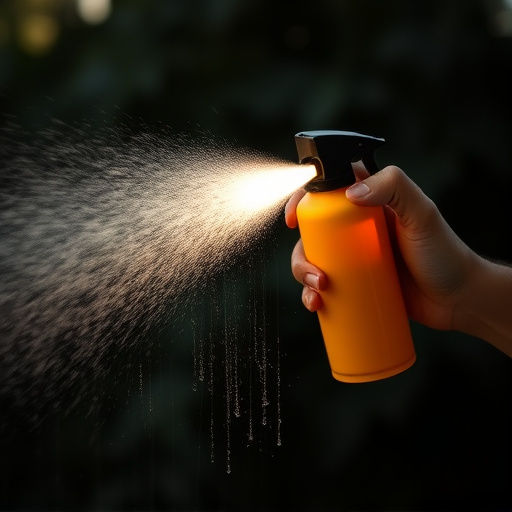Tactical pepper spray, a non-lethal self-defense tool using capsaicin from chili peppers, offers versatile deployment methods—from direct application to advanced devices—for outdoor and indoor settings. Law enforcement agencies globally employ it for crowd control, arrest assistance, prison security, and hazardous material response teams, with comprehensive training and safety measures in place. The legal use of tactical pepper spray is regulated globally, balancing public safety and individual rights, with strict compliance and training requirements to ensure legitimate defensive use.
“Unveiling the power of capsaicin, the active ingredient in tactical pepper spray, this article delves into its role as an inflammatory agent deterrent. From understanding the science behind capsaicin’s heat-inducing properties to exploring effective deployment methods for law enforcement agencies, we dissect optimal tactical applications.
Learn about safety considerations, real-world use cases ranging from personal defense to industrial settings, and the legal framework surrounding pepper spray usage. Discover best practices for tactical pepper spray deployment methods and stay informed about this crucial self-defense tool.”
- Understanding Capsaicin: The Active Ingredient in Pepper Spray
- Tactical Deployment Methods for Optimal Effectiveness
- Safety Considerations and Training for Law Enforcement Agencies
- Real-World Applications: From Personal Defense to Industrial Use
- Legal Implications and Regulatory Framework Surrounding Pepper Spray Usage
Understanding Capsaicin: The Active Ingredient in Pepper Spray
Capsaicin, the active ingredient in pepper spray, is a natural compound derived from chili peppers. It’s what gives spicy foods their heat and has powerful effects on the human body when used tactically. When deployed, capsaicin irritates the eyes, nose, and respiratory system by binding to specific receptors, leading to temporary disorientation and physical hindrance. This makes tactical pepper spray a valuable tool for self-defense, law enforcement, and military operations, as it offers a non-lethal means of neutralizing threats.
The deployment methods for tactical pepper spray vary depending on the situation and user preference. Common techniques include finger-tip application, where a small amount is directly sprayed onto an attacker’s face, and use in specialized devices like air or ballistic sprays that project larger volumes over greater distances. Each method ensures swift and effective neutralization while minimizing risk to users and bystanders, making capsaicin a versatile and potent ingredient in personal defense strategies.
Tactical Deployment Methods for Optimal Effectiveness
When deploying capsaicin inflammatory agent deterrent spray tactically, understanding optimal application methods is key to maximizing its effectiveness. For outdoor use, targeted spraying directly onto suspected intruders or threatening animals is most effective. This direct approach ensures the pepper spray comes into direct contact with the subject’s eyes and respiratory system, causing irritation and disorientation.
Indoor deployment requires a slightly different strategy. Spraying in well-ventilated areas or directly at the threat source, while avoiding excessive fogging that could obscure vision, allows for quicker absorption of capsaicin. Training and familiarization with the sprayer’s range and distribution patterns are vital to ensure accurate and safe tactical deployment in various environments.
Safety Considerations and Training for Law Enforcement Agencies
When it comes to tactical pepper spray deployment methods, safety considerations are paramount for law enforcement agencies. Training should encompass proper handling techniques to minimize exposure and reduce risks associated with capsaicin inflammatory agent deterrents. Officers must learn effective application strategies, including target areas, distance, and timing, to ensure the safe and successful use of such sprays.
Regular simulations and practical exercises can help familiarize officers with different scenarios and deployment methods, enhancing their ability to make quick decisions in high-pressure situations. Additionally, equipping law enforcement with personal protective equipment (PPE), such as gloves, eye protection, and respirators, is essential. These measures safeguard both the officers and those in close proximity during tactical operations involving pepper spray.
Real-World Applications: From Personal Defense to Industrial Use
In real-world scenarios, capsicin inflammatory agent deterrent spray, commonly known as tactical pepper spray, finds applications beyond personal defense. Law enforcement agencies worldwide employ it as a non-lethal weapon to subdue and control aggressive individuals during arrests and crowd management. The spray’s ability to induce temporary blindness, coughing, and difficulty breathing makes it an effective tool for maintaining public safety.
Industrial use of tactical pepper spray is also prevalent, particularly in high-risk environments like prisons, security facilities, and hazardous material response teams. It serves as a deterrent during escape attempts, riot control, and situations requiring rapid de-escalation. The versatility of deployment methods—handheld canisters, ballistic launchers, or even integrated into protective gear—makes it adaptable to various tactical scenarios, ensuring the safety of personnel and bystanders alike.
Legal Implications and Regulatory Framework Surrounding Pepper Spray Usage
The legal implications and regulatory framework surrounding tactical pepper spray deployment methods vary significantly across jurisdictions, reflecting a delicate balance between public safety and individual rights. In many countries and states, law enforcement agencies are permitted to use capsaicin inflammatory agent deterrents as a non-lethal force option during certain high-risk situations. However, strict guidelines and training protocols govern their application to ensure responsible usage. Non-compliance with these regulations can lead to severe legal consequences for both the users and manufacturers, including civil liabilities, fines, and criminal charges.
Regulatory bodies often mandate specific criteria for product safety, efficacy, and labeling, ensuring that tactical pepper spray meets established standards. These include requirements for capsaicin concentration, delivery mechanisms, and instructions for safe handling and storage. Compliance with these standards not only safeguards users but also strengthens the case for defensive use in legal proceedings, emphasizing the responsible deployment of such powerful agents within a structured legal framework.
Capsaicin inflammatory agent deterrent spray, commonly known as pepper spray, is a powerful tool with diverse applications. Understanding its active ingredient, tactical deployment methods, and safety considerations is paramount for optimal effectiveness. Law enforcement agencies must prioritize training to ensure responsible usage, while its legal implications demand adherence to regulatory frameworks. By employing tactical pepper spray deployment methods effectively, users can leverage this tool’s capabilities for personal defense, industrial security, and public safety, making it a versatile game-changer in today’s diverse landscape.
